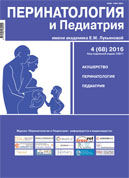Определение роли ведущих генетических и клинических факторов в развитии невынашивания беременности
DOI:
https://doi.org/10.15574/PP.2016.68.42Ключевые слова:
полиморфизм генов, невынашивание беременностиАннотация
Цель — определить полиморфизм генов-кандидатов в развитии невынашивания беременности для усовершенствования системы мер по его предупреждению.
Пациенты и методы. В работе использованы клинические, генетические, биохимические, эндокринологические, ультразвуковые, статистические методы исследования.
Результаты. Статистический анализ гипотез, определяющих характер распределения неблагоприятных вариантов аллельного полиморфизма исследуемых генов (показатели) в группах женщин с невынашиванием беременности и в контрольной группе показал, что они отличаются от равномерного. Также установлены две наиболее частые комбинации аллельных полиморфизме генов-кандидатов у женщин с невынашиванием.
Выводы. В результате исследования сформирована современная концепция (причинно-следственная связь) развития невынашивания беременности. На ее основе создана система профилактики и лечения женщин с невынашиванием до и во время беременности. Ее эффективность подтверждается перинатальными последствиями в группах риска невынашивания.
Ключевые слова: полиморфизм генов, невынашивание беременности.
Библиографические ссылки
Bespalova ON. 2009. Genetic risk factors for miscarriage. Abstract, dis ... d-ra med sciences. SPb: 36.
Boris AM. 2012. Polymorphisms of FSH receptors (ESHR) and E2 (ESR2) in patients with chronic anovulation greendragon that require infertility treatment conducting VRT. Immunology and Allergology. 3: 29-34.
Veropotvelyan PM, Veropotvelyan NP, Erucic SP. 2012. Polymorphism of enzymes of estrogen metabolism in patients with hyperplasia in the endometrium in the late reproductive age. Pediatrics, obstetrics and gynecology. 75; 5: 73-75.
Vorob'eva, II. 2005. Recurrent pregnancy Loss: the role of hormonal factors. Current issues of miscarriage and premature newborns. Kyiv: 18-25.
Zaporozhan VM, Marcaida VG, Kulesh AM. 2012. Polymorphism of the gene encoding the Transporter of reduced folates RFC1, and congenital neural tube defects of the fetus. Actual issues of Pediatrics, obstetrics and gynecology. Ternopil. 1: 126-128.
Kovaleva AM. 2012. Analysis of the relationship between I/D gene polymorphism of the angiotensin-converting enzyme with the development of sepsis and pneumonia in prematurely born children. CLDC and experim pathology. Chernivtsi. 11; 4: 77-81.
Kudinov VV. 2011. Effects of pregnancy, childbirth, and neonatal status in women with recurrent pregnancy loss who underwent metabolic correction. Reproductive endocrinology. 2: 26-29
Vorobyova II, Rzepecka-Denisov AA, Pisareva SP, Tkachenko VB, Rudakov N, Obukhov YuG. 2011. Novi pahadi to treatment zagrozi peredivannya watnot. Tauride medical and biological Bulletin. 14; 3; 2(55): 60-63.
Zaporozhan VM, Marcaida VG, Kulish AM, Cavalli P. 2011. The role of polymorphisms of genes MTHFR and MTRR in the formation of congenital neural tube defects of the fetus in the southern region of Ukraine. Integrative anthropology. Odesa. 2: 4-6.
Shirshev SV. 2009. Immunology of maternal-fetal interactions. Ekaterinburg, UrO RAN: 582.
Laird S, Tuckerman E, Cork B et al. 2003. A review of immune cells and molecules in women with recurrent miscarriage. Hum Reprod Update. 9(2): 163—174. https://doi.org/10.1093/humupd/dmg013; PMid:12751778
Tempfer CB, Dorman K, Deter RL et al. 2001. An endothelial nitric oxide synthase gene polymorphism is associated with preeclampsia. Hypertens Pregnancy. 20; 1: 107—118. https://doi.org/10.3109/10641950109152647; PMid:12044319
Tempfer CB, Dorman K, Deter RL et al. 2001. An endothelial nitric oxide synthase gene polymorphism is associated with preeclampsia. Hypertens Pregnancy. 20; 1: 107—118. https://doi.org/10.3109/10641950109152647">https://doi.org/10.3109/10641950109152647; PMid:12044319
Barbui T. 2005. Antiphospholipid syndrome: clinical and diagnostic utility of laboratory tests. Semin Thromb Hаemost. 31(1): 17—24. https://doi.org/10.1055/s-2005-863801; PMid:15706471
Bick RL. 2002. Disorders of thrombosis and haemostasis. Сlinikal and laboratory practice. Lippincott Williams and Walkins. Third edition: 400.
Prigoshin N, Tambutti M, Larriba J et al. 2004. Cytokine Gene Polymorphisms in Recurrent Pregnancy Loss of Unknown Cause. American Journal of Reproductive Immunology. 52; 1: 36-41. https://doi.org/10.1111/j.1600-0897.2004.00179.x; PMid:15214940
Foka ZJ, Lambropoulos AF, Saravelos H et al. 2000. Factor V Leden and prothrombin G20210A mutations, but not methylenetetrahydrofolate reductase C677T, are associated with recurrent miscarriages. Human Reproduction. 24; 2—3: 123—130.
Tempfer CB, Simoni M, Destenaves B, Fauser BCJM. 2009. Functional genetic polymorphisms and female reproductive disorders: Part II-endometriosis. Human Reproduction Update. 15; 1: 97-118. https://doi.org/10.1093/humupd/dmn040; PMid:18805939 PMCid:PMC2639061
Daher S, Mattar R, Gueuvoghlanian-Silva B, Torloni M. 2012. Genetic polymorphisms and recurrent spontaneous abortions: an over-view of current knowledge. Am J Reprod Immunol. 67; 4: 341—347. https://doi.org/10.1111/j.1600-0897.2012.01123.x; PMid:22390536
Yamada SF, Kondo T et al. 2003. Glutathione S-transferase M1 and T1 polymorphisms and the risk of recurrent pregnancy loss. Mol Hum Reprod. 9; 3: 165—169. https://doi.org/10.1093/molehr/gag021; PMid:12606593
Bahar AM, Ghalib HW, Moosa RA. 2003. Maternal serum interleukin-6, interleukin-8, tumor necrosis factor-alpha and interferon-gamma in preterm labor. Acta Obstet Gynec Scand. 82; 6: 543—546. https://doi.org/10.1080/j.1600-0412.2003.00156.x; https://doi.org/10.1034/j.1600-0412.2003.00156.x; PMid:12780425
Neilson J, Gyte G, Hickey M et al. 2013. Medical treatments for incomplete miscarriage. Cochrane Database Syst Rev. 28: 37. https://doi.org/10.1002/14651858.cd007223.pub3
Buchholz T, Lohse P, Rogenhofer N et al. 2003. Polymorphisms in the ACE and PAI-1 genes are associated with recurrent spontaneous miscarriages. Human Reproduction. 18; 11: 2473—2477. https://doi.org/10.1093/humrep/deg474; PMid:14585904
Akisu V, Balim Z, Cetin H et al. 2004. The role of angiotensin-converting enzyme and apoliprotein — E polymorphisms on lipid composition in newborn infants with intrauterine growth restriction. Early Hum Dev. 78; 2: 95—103. https://doi.org/10.1016/j.earlhumdev.2004.03.006; PMid:15223114
Venkata Suryanarayanal, Mamata Deenadayal, Lalji Singh. 2004. Association of CYP1A1 gene polymorphism with recurrent pregnancy loss in the South Indian population. Human Reproduction. 19; 11: 2648—2652. https://doi.org/10.1093/humrep/deh463; PMid:15333597
Waites KB, Katz B, Shelonka RL. 2005. Mycoplasmas and ureaplasmas as neonatal pathogens. Clin Microbiol Rev. 18(4): 757—789. https://doi.org/10.1128/CMR.18.4.757-789.2005; PMid:16223956 PMCid:PMC1265909

